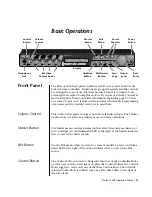
you like, etc. These features are a gift from the developers/coders, as are the
Croutes; they weren’t spec’d and are powerful, creative and much appreciated!
The Engine Optimizer also resides here; this controls the smoothing done to the
digitally-sourced control signals that are applied to the A6’s analog parameters,
to avoid stepping, zipper noise, etc. In other words, to produce the most analog
response available, versus older synths which might stair-step when changing a
parameter due to lesser resolution. (The Virus adds a lag to the Filter cutoff
control, if I remember correctly, in order to guarantee a smooth response.)
The A6, due to it’s enormous feature set, maxes out the capabilities of the
Coldfire processor (and is designed to behave the same when using any amount
of Mods), and benefits from a particular amount of smoothing in certain
parameters, such as in PWM via LFO, etc. This is a compromise and can be
adjusted if it doesn’t suit the user.
The Osc chip houses the oscillators, PWM, etc., and the Slow settings are
recommended for LFO modulation of PW. This may cause a slight slewing of
oscillator pitch, as all of the parameters are tied together, and as such is
recommended for pads with some amount of audio fade-in.
The Filter chip houses the Filters and the output VCAs. The Fastest setting will
allow for sharper percussion sounds, especially the type produced by analog
drum machines and popularized by Kraftwerk, etc. I’ve noted in creating a
Minimoog-style sound with Erik Norlander (then the Synthesizer Group manager
and more), that the setting just below the Fastest is appropriate, owing to the
Minimoog’s relatively slow envelopes. It felt more like the Mini in direct
comparison.
At the Fastest settings, extreme amounts of modulation to Oscillator and Filter
frequency can result in detectable stepping and zippering.
Audio Rate FM, Oscillators and Filters
-Analog Noise can be used as audio into the Filters by selecting
a Noise Type and Level in the Pre Filter Mix module and
then turning Soft Pot 8 on that page to Enable Aud In.
Noise can also be used to modulate the Filter frequencies.
Turn Aud In to Off, press the View button on the Filter(s)
you wish to modulate, and use Soft Pot 8 to select Ext In.
The Pre Filter Mix Noise Level pot will then act as an
attenuator for the modulation. The Mod on this pot will act
as a dynamic modulator of this route.
-Oscillator modulation of the Filter frequencies is accomplished
by selecting the Oscillator Wave page(s) and Enabling
CV Out, the 8th Soft Pot. This is a per-Oscillator switch.
Both can modulate Fc simultaneously, but in equal amounts
that are attenuated by a single control (Soft Pot 7 on Filter 1,
CV In. You must select Osc CV on each Filter on Soft Pot 8.




























